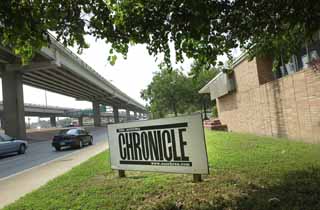What Hath TxDOT Wrought?
Fri., Sept. 20, 2002

From 51st to UT
Mueller and 51st Street
At the southern boundary of the old Mueller site, just south of 51st, you're looking at 21 lanes of traffic: five main lanes in each direction, two elevated HOV lanes, and a total of nine lanes of frontage road. But those lanes are spread out over a right-of-way nearly doubled in width from the status quo, taking out several hundred new feet on the southbound (west) side and 100 feet or so on the northbound (east) side.
A flyover will dump HOV traffic into Mueller (not all that gracefully, according to these drawings), but regular I-35 traffic heading for that high-density redevelopment project -- expected to generate tens of thousands of trips a day -- will have to exit at 51st (northbound) as it does now, or exit at Airport (southbound) and turn around. (There will be even more traffic if, as has been proposed by Catellus Development -- the prospective Mueller master developer -- a regional retail center goes at I-35 and 51st, instead of the office campus called for in the Mueller master plan.)

All the new asphalt includes a more-or-less complete rebuild (and major expansion) of the reviled 51st Street interchange, including separate northbound exits for 51st and for Cameron Road. But awkward moments remain. Traffic turning from 51st southbound won't be able to enter the main lanes until about 41st Street, after crossing Airport Boulevard. If you get on the southbound frontage road north of 51st, you can make it to the freeway sooner -- after passing under the drivers who took the Airport exit.
Bridging Airport Boulevard
At the railroad tracks south of Airport, the highway would have 19 lanes (11 main lanes total, three frontage lanes in each direction, and the two HOVs), but in a more compact and somewhat more coherent arrangement (though still wide enough to take out the old Academy Sporting Goods, the Sears auto shop, and part of the Chronicle's offices [photo A] at 40th Street). This design tears down the existing upper deck, but to clear the railroad tracks, TxDOT has proposed a huge overpass from north of Airport almost to 41st Street -- about half a mile.
North of this bridge, the planned highway is basically at grade; the structure will take drivers to 23 feet above the tracks, and then down to 16 feet below grade at 37th. The main lanes would remain below grade south to 15th Street, come back up, and then sink back down from 11th to Holly Streets.
Meandering Right-of-WayAt 32nd Street, you have 19 lanes, but in a wider right-of-way that zigs and zags to avoid the most problematic neighbors. From 37th south to 30th, the southbound frontage road is cantilevered over the main lanes (see cross-section below) to accommodate Concordia University (which just built new dorms on the frontage road) and St. David's Medical Center. Even with this device, TxDOT still plans to take 150-plus feet of new right-of-way on the east side (taking out, among other things, the Star Seeds Cafe (photo B) and People's Community Clinic). As the cross-section shows, most of that land would not actually be paved.
From 26th (Dean Keeton) to Manor, the profile is reversed: to avoid Mount Calvary Cemetery, the northbound frontage road is cantilevered, and the southbound right of way widens by 100 feet or more, taking out the new UT practice facility, aka the Longhorn dome (photo C), and necessitating a major realignment of Red River, as southbound traffic exiting to 26th goes almost to Manor Road before looping back on Red River.
Again, TxDOT is quite fond of split-level solutions; southbound just past 26th, traffic entering the highway passes over people exiting. The reverse happens northbound, just north of 32nd.

From UT to Town Lake
More Right-of-Way
South of 11th, TxDOT's proposal shaves off the front of buildings (like the Capital Marriott parking garage) on the west side -- up to APD headquarters on Eighth.

Because both main lanes and C/D lanes are well below grade, getting on the freeway here involves (once again) climbing over the people trying to get off.
HOV North
The HOV lanes split south of Manor Road, near the UT track and soccer stadium, into major flyovers that end at Martin Luther King; the HOVs don't continue through downtown, though new ones emerge near Cesar Chavez. There's no obvious way for traffic to enter the HOV from, or exit onto, the freeway itself. Downtown drivers would have to exit at MLK and then re-enter, flying over seven lanes of traffic. Southbound HOV drivers would be deposited in the far right lane at MLK, and then would have about 100 feet to cross over four lanes and get back on the freeway.
HOV South
The C/D lanes end, and new HOV lanes emerge, near Cesar Chavez, with some of the same oddities -- northbound drivers taking the HOV across the river will fly over eight blocks of downtown before actually getting to the frontage road.
Mostly to accommodate the HOV and the split for the C/D lanes, TxDOT proposes taking a lot of right-of-way on the east side, although at least one of these properties -- at 501 N. I-35 -- has already been spared because it's a historic building.
Street Level
Aside from the upper deck disappearing, the biggest change to I-35's current profile will be on the south side of downtown -- freeway drivers will go under, instead of over, Seventh, Sixth, and Cesar Chavez, as well as Fifth Street, which doesn't cross I-35 now. However, TxDOT's plans show no crossing (over or under) at Fourth St. (photo E) -- a problem, since Fourth is slated for both light rail, should it happen, and the Lance Armstrong Bikeway. And, in case you're wondering -- yes, TxDOT's plans involve rebuilding, and widening, the bridge across Town Lake.
Express and C/D LanesJust north of MLK, as the HOV lanes end, the highway sprouts "collector/distributor lanes" (C/D), which is a euphemism for "making the road wider" or "building two decks, just side by side." Between MLK and Cesar Chavez, there will be three or four main lanes in each direction, in the center, with no on- or off-ramps; three or four C/D lanes on either side of those, with entrances and exits; and then three or four lanes of frontage road on either side of that. At 11th Street, that translates into 20 lanes of traffic, side by side in a 406-foot of right-of-way (see cross-section below).
However, because the existing right-of-way between MLK to 12th is already nearly that wide -- to accommodate the split into upper and lower decks (photo D) -- TxDOT needs no new land at all on the west side (Brackenridge Hospital and the Erwin Center), and not nearly as much on the east side as it's taking further north. (The fact that Swede Hill, the neighborhood across from the Erwin Center, is a National Register historic district is another incentive.)
Got something to say on the subject? Send a letter to the editor.










